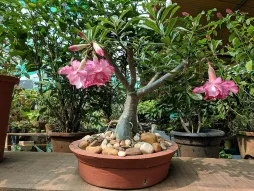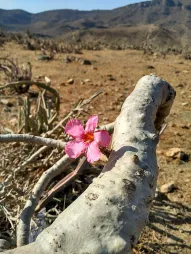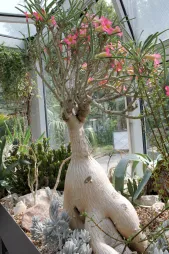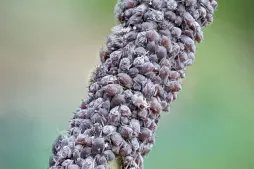Adenium boehmianum, a desert rose with contrasting flowers
Less well known than other desert roses, such as adenium obesum or adenium multiflorum, Adenium boehmianum is native to south-west Africa. This member of the Apocynaceae family stands out for its contrasting flowers.
How to recognize the desert rose Adenium boehmianum?
Adenium boehmianum is a semi-succulent shrub with an upright, bushy habit. It can reach two meters in height.
The thick trunk is branched. It is topped by twisted branches with gray or brown bark. At the base, it forms a caudex. This bulge acts as a water reserve, enabling the plant to survive in desert climates.
The deciduous foliage is made up of single, full leaves,growing in rosettes directly on the branches. They are stalkless and stalkless. Blades are oval, up to 15 cm long and 8 cm wide. The shiny green upper surface is decorated with prominent white veins. The reverse side is paler green.
Flowering lasts a few weeks, often appearing before the first leaves. The trumpet-shaped flowers have five petals. They bloom in groups at the ends of branches. White or light pink, they have dark centers.
In the wild, Adenium boehmianum produces fruit. These are two fused follicles that can exceed 20 centimetres in length.
Like all desert roses, Adenium boehmianum is toxic. It contains a white latex containing alkaloids. This substance is a deadly poison. Hunters in Namibia and Botswana used it to coat their arrows, ensuring the death of their prey. So keep your plant out of the reach of your pets. Wear gloves when repotting.
Our maintenance tips
You can propagate your Adenium boehmianum by sowing or cutting. Sowing produces a plant identical to the mother plant. With cuttings, your new specimen will not develop a caudex.
Watering
Allow the substrate to dry for about five centimetres before watering. Use non-calcareous water, such as rainwater. Moisten the soil without soaking it.
Wait for the water to drain through the drainage holes before putting your plant back in its place. Empty any water stagnating in the dish. It may rot the roots.
Spray
Your adenium boehmianum hates wet foliage. You must not mist the plant.
Repotting
In spring, transfer your Adenium boehmianum to a larger pot, so that it can continue to grow.
Get a pot with holes larger than the root ball of your Adenium boehmianum.
Adenium boehmianum appreciate a light, draining substrate. You can plant your specimen in potting soil for cacti and succulents. You can also make your own growing medium by mixing equal parts potting soil and a draining material such as sand, perlite or pozzolan.
Place a layer of substrate at the bottom of the pot. Plant your Adenium boehmianum in the center. Then add potting soil. In young plants, the caudex grows better when buried. If your plant is less than four years old, bury two-thirds of it. If it's older, you can leave it on the surface.
Water generously to facilitate rooting.
Fertilization
You can stimulate the development of your plant during its growth phase, in spring and summer, with fertilizer.
Use a cactus and succulent or Mediterranean plant fertilizer to encourage the growth of your Adenium boehmianum.
Prune
Remove wilted flowers. If you can't cut the flower stem with your hands, you can use pruning shears. Remember to clean your tool beforehand to prevent disease transmission.
Seedling
Prepare a light, draining substrate, for example 50% potting soil for cacti and succulents, 25% pozzolana and 25% sand. Pour your mixture into plastic cups.
Plant your seeds, covering them with two to three centimetres of substrate. You can put several seeds in the same pot.
Sowing is done in the air. Place your pots in a mini-greenhouse or cover them with a bottle or translucent plastic bag.
Mist the substrate regularly to keep it moist. Don't forget to air the pots a few minutes a day.
Cutting
Cutting is carried out during the strong growth phase, generally in spring and early summer.
Locate a healthy, flowerless branch. Cut a section with several leaves about 10 centimetres long. Use a clean, sharp tool to facilitate healing.
Leave your cutting to dry for 24 to 72 hours, until a callus forms.
In a pierced terracotta pot, pour a bed of clay balls or gravel to optimize drainage.
Prepare a mixture of one-third potting soil, one-third garden soil and one-third sand. Pour it into your pot, on top of the drainage layer. Plant your cutting and tamp it down.
Place the pot in a room where the temperature is always above 18 degrees. The location should be bright and out of direct sunlight. You can, for example, place your cutting behind a curtained window.
To avoid drowning the roots, always check the condition of the substrate before watering: the surface must be dry.
Diseases / Threats
Information
| Family | Apocynaceae - Apocynaceae |
| Type | Desert rose - Adenium |
| Species | Adenium boehmianum - Adenium boehmianum |
| Lifecycle | Perennial |
| Foliage | Deciduous |
| Exposure | |
| Substrats | |
| Planting methods |
In pots In tubs Bucket |
| Categories | |
| Tags |
Flowery Fritillary Toxic |
| Origin |
South Africa |
| Hardiness (USDA) | 11b |
| Leaf color |
|
| Flower colors |
|
Discover plants from the same family

Adenium obesum
Discover

Adenium dhofarense
Discover

Adenium multiflorum
Discover

Adenium oleifolium
Discover



















